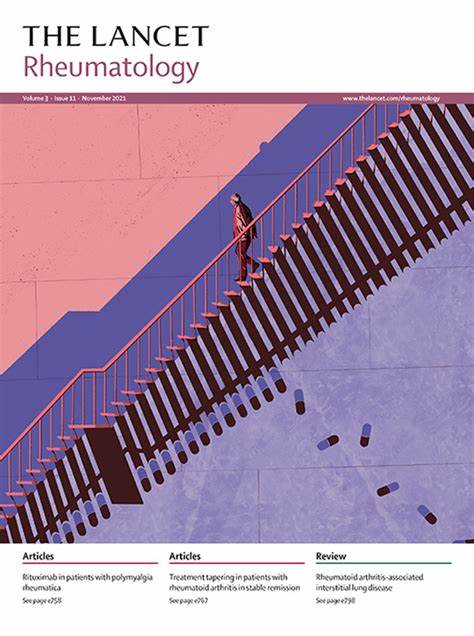Cardiovascular events in patients with gout initiating urate-lowering therapy with or without colchicine for flare prophylaxis: a retrospective new-user cohort study using linked primary care, hospitalisation, and mortality data
IF 16.4
1区 医学
Q1 RHEUMATOLOGY
引用次数: 0
Abstract
Background
Initiating urate-lowering therapy can trigger gout flares. Gout flares have been associated with a temporally increased risk of cardiovascular events. Therefore, we aimed to estimate the risk of cardiovascular events in patients with gout initiating urate-lowering therapy with flare prophylaxis using colchicine (the drug recommended for gout flare prohphylaxis by many international societies) compared with no prophylaxis.
Methods
We did a retrospective new-user cohort study using data from the Clinical Practice Research Datalink Aurum, an English primary-care database linked to hospitalisation and mortality records. People with gout initiating urate-lowering therapy for the first time were eligible for inclusion. We compared people prescribed flare prophylaxis with colchicine with those not prescribed any gout flare prophylaxis. Colchicine prophylaxis (defined as prescription for ≥21 days) prescribed on the same date as urate-lowering therapy was the exposure of interest. A composite of fatal and non-fatal myocardial infarction or stroke within 180 days after urate-lowering therapy initiation regardless of any previous cardiovascular event was the primary outcome. Propensity score overlap weighting was used to balance covariates across study groups. We used Cox regression and performed intention-to-treat and per-protocol analyses, the latter with an inverse probability of censoring weighting. The association was measured using hazard ratio and risk difference with 95% CIs. Members of The UK Gout Society were involved in prioritising the research question.
Findings
Of the 111 460 patients eligible for the study, 99 800 patients with gout initiating urate-lowering therapy were included. 25 511 (25·6%) of 99 800 patients were female, 74 289 (74·4%) were male, 84 928 (85·1%) patients were White and the mean age was 62·8 years (SD 15·5). 4063 (4·1%) patients had previous cardiovascular events and 16 028 (16·1%) patients were prescribed colchicine prophylaxis. Patients with colchicine prophylaxis had significantly lower risk of cardiovascular events compared with those without prophylaxis. The weighted rates of cardiovascular events were 28·8 per 1000 person-years (95% CI 25·2 to 33·2) in patients with colchicine prophylaxis and 35·3 per 1000 person-years (33·0 to 37·9) in those without prophylaxis (weighted rate difference –6·5 [95% CI –9·4 to –3·6] per 1000 person-years and weighted hazard ratio 0·82 [0·69–0·94]) in the intention-to-treat analysis. Findings were similar across analytical approaches, stratified analyses, and for secondary outcomes.
Interpretation
In patients with gout initiating urate-lowering therapy, the risk of cardiovascular events was reduced in those prescribed colchicine prophylaxis compared with no prophylaxis. These findings provide an additional argument for using colchicine for gout flare prophylaxis.
Funding
Foundation for Research in Rheumatology.
使用秋水仙碱或不使用秋水仙碱进行降尿酸治疗的痛风患者的心血管事件预防:一项回顾性新用户队列研究,使用相关的初级保健、住院和死亡率数据。
背景:开始降尿酸治疗可引发痛风发作。痛风发作与心血管事件的风险暂时增加有关。因此,我们的目的是评估与不进行预防相比,使用秋水仙碱(许多国际协会推荐用于预防痛风耀斑的药物)进行降低尿酸盐治疗的痛风患者心血管事件的风险。方法:我们使用临床实践研究数据链Aurum(一个与住院和死亡率记录相关的英国初级保健数据库)的数据进行了一项回顾性新用户队列研究。首次接受降尿酸治疗的痛风患者符合入选条件。我们比较了使用秋水仙碱预防耀斑的患者和未使用任何预防痛风耀斑的患者。与降尿酸治疗同日服用秋水仙碱预防(定义为处方≥21天)是感兴趣的暴露。在开始降尿酸治疗后180天内发生致死性和非致死性心肌梗死或卒中的综合情况,而不管之前是否发生过心血管事件,是主要结局。倾向评分重叠加权用于平衡各研究组间的协变量。我们使用Cox回归并进行意向治疗和协议分析,后者具有反向审查权重的概率。使用风险比和95% ci的风险差异来测量相关性。英国痛风协会的成员参与了研究问题的优先排序。结果:在符合研究条件的11460例患者中,有99800例痛风患者开始接受降尿酸治疗。99 800例患者中女性25 511例(25.6%),男性74 289例(78.4%),白人84 928例(85.1%),平均年龄62.8岁(SD 15.5)。4063例(4.1%)患者既往有心血管事件,16028例(16.1%)患者使用秋水仙碱预防。与未使用秋水仙碱预防的患者相比,使用秋水仙碱预防的患者发生心血管事件的风险显著降低。在意向治疗分析中,秋水仙碱预防组的心血管事件加权率为28.8 / 1000人-年(95% CI 25.2 ~ 33.2),未预防组的心血管事件加权率为35.3 / 1000人-年(33.0 ~ 37.9)(加权率差为- 6.5 [95% CI - 9.4 ~ -3] / 1000人-年,加权风险比为0.82[0.69 ~ 0.94])。分析方法、分层分析和次要结果的结果相似。解释:在开始降尿酸治疗的痛风患者中,秋水仙碱预防与未预防相比,心血管事件的风险降低。这些发现为使用秋水仙碱预防痛风耀斑提供了额外的论据。资助:风湿病学研究基金会。
本文章由计算机程序翻译,如有差异,请以英文原文为准。
求助全文
约1分钟内获得全文
求助全文
来源期刊

Lancet Rheumatology
RHEUMATOLOGY-
CiteScore
34.70
自引率
3.10%
发文量
279
期刊介绍:
The Lancet Rheumatology, an independent journal, is dedicated to publishing content relevant to rheumatology specialists worldwide. It focuses on studies that advance clinical practice, challenge existing norms, and advocate for changes in health policy. The journal covers clinical research, particularly clinical trials, expert reviews, and thought-provoking commentary on the diagnosis, classification, management, and prevention of rheumatic diseases, including arthritis, musculoskeletal disorders, connective tissue diseases, and immune system disorders. Additionally, it publishes high-quality translational studies supported by robust clinical data, prioritizing those that identify potential new therapeutic targets, advance precision medicine efforts, or directly contribute to future clinical trials.
With its strong clinical orientation, The Lancet Rheumatology serves as an independent voice for the rheumatology community, advocating strongly for the enhancement of patients' lives affected by rheumatic diseases worldwide.
 求助内容:
求助内容: 应助结果提醒方式:
应助结果提醒方式:


